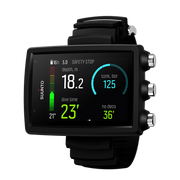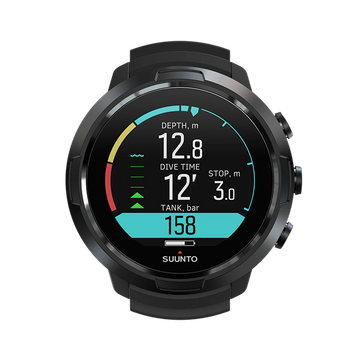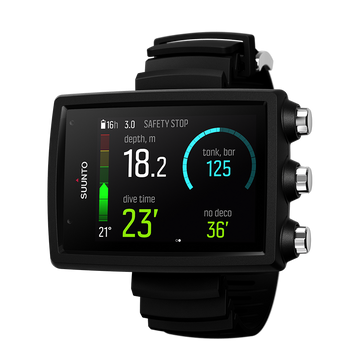

Suunto Blog

9 rules to follow when your trip in the mountains goes pear-shaped
Spend enough time in the mountains and you learn to expect the unexpected. You might start out in delightfully warm weather and then, surprise, a storm arrives and covers the landscape in snow. Didn’t see that coming!
In the second article in this series on wayfinding, we talked about how to plan a route in the mountains. In the third article, we explained how to stay on track when you’re out on a trip. In this article we look at how to react when conditions get difficult.
Thing is, even the best laid plans can and probably will go awry. It’s important to understand your plan is just a plan. The world around you marches to its own drumbeat.
Photo by Tim Tiedemann on Unsplash
3 general rules
Be responsive
Our resident navigator-in-chief Terho Lahtinen advises to expect the unexpected. You don’t want to get too vigilant and uptight, however, because then nothing is much fun. Just keep it in the back of your mind that things can change, and to be responsive when they do.
Terho says to cultivate this quality it’s good to go through different scenarios in advance of the trip and to have plans for each of them.
“In the mountains, you should always have a plan B for surprises: a shorter route, extra clothing, first aid kit, backup navigation device, and so on,” he says. “Having the right equipment and skills to use them properly is the best preparation.”
Stay calm
Goes without saying, but when things take a turn for the unexpected it’s important not to panic. Panic impairs our decision making ability, which can be a big deal in the backcountry. Instead, do something to help you relax.
“When you encounter an unwanted situation, make a stop, have a snack, find shelter if possible and put on an extra layer to keep warm,” Terho says. “It’s more important to make the right decision rather than a quick one that turns out wrong.”
Consider all options
Once you’ve settled down, consider all your options. Talk with your group and see how everyone is feeling. What options suit the skill level and comfort zone of your group?
“Sometimes the conditions are just not on your side and the only reasonable plan B is to postpone the trip,” Terho says. “This can be a very hard decision if it’s a long-awaited adventure, but it’s better to be safe than sorry.”
This is when a Suunto 9 comes in handy. The watch’s Find Back function guides you directly back to your starting point via a breadcrumb trail on the watch face. You can also store Points of Interest on the go and navigate back to them.
Photo by asoggetti on Unsplash
Specific rules for low visibility
One typical thing that can catch people out in the mountains is poor visibility, whether caused by fog, rain, snow or low light. You have to pay extra attention in any of these conditions, and really consider what options are the best for you and the group.
Easy does it
In low visibility always choose the easiest route to follow. Stay on a marked trail instead of taking an off track shortcut.
“If there are no trails, use obvious terrain features as checkpoints that you are sure to recognize,” Terho says.
Know your location
One of the ways people get into trouble in the mountains is by pushing on hastily without being sure about their location. In low visibility, take the time to regularly check in with your map.
“If you lose your location on the map, it is much more difficult to find it again if you can’t see your surroundings,” Terho says. “In practice, you will need to pay attention to all details in the terrain that you can identify on the map, and also work through the terrain features that you expect to see when moving on.”
Keep track of time
Monitoring your travel time is essential to estimate the distance you have traveled. This is important because in low visibility it will help you estimate where you likely are on the map.
“It’s worth noting that in poor visibility we tend to overestimate the distance traveled and the pace often gets slower when visibility drops,” Terho says. “When trying to spot yourself on the map, remembering this limits the radius of where to look on the map.”
A stream can act as a handrail to lead you to the next terrain feature. Photo by Hamed Alayoub on Unsplash
Follow handrails
We talked about using handrails as navigation aids in the previous article in this series. They can be particularly useful in low visibility, even as reassurance.
“A good handrail is a clear terrain feature that you can easily follow, such as a creek, river, hillside, a fence or the treeline,” Terho explains. “Sometimes you can also use the elevation of the handrail as an additional navigation aid.”
Use all your tools
When you’re way out in the backcountry far from help or above the treeline and exposed to the elements, time is of the essence. Cold is the enemy. Use all your tools to help you stay on track and safe. Your compass, watch, altimeter, GPS device – each one can help you.
“Use your compass to check the trail you’re on goes in the right direction,” Terho says. “Check the time every now and then; knowing your average pace and the time in the last known location helps to estimate how far you could have traveled. An altimeter is also a practical tool. For instance, working out your location on a trail that goes up or down a slope can be done with an altitude reading. As a backup, it’s also good to have a GPS like a Suunto 9 watch with the most important waypoints and the planned route stored.”
Wait it out
Sometimes the best thing you can do is to find shelter asap. Especially in cold conditions, staying warm is the priority. Hypothermia, when your body loses heat faster than it can produce it, can set in within minutes to hours, depending on the temperature.
“There are times when the best option is to pitch camp, sleep over and evaluate the options again next morning,” Terho says.
Lead image: Photo by Philipp Reiter
Read more articles
How to find your way in the mountains
7 tips to plan a route in the mountains
A veteran navigator's 9 tips to stay on track in the mountains

Don’t get sucked into the black hole
There’s a training pattern that eats away your improvements. Suunto partner PerfectPace explains the black hole and how to avoid it.
Many of us know this scenario: your training plan has you scheduled for an easy recovery run that mysteriously becomes faster and faster. Maybe it’s because you are motivated and feel good or because you don’t want to be overtaken by that runner just behind you. Sounds innocent enough, right? Thing is, running just a bit faster than you are supposed to can destroy your training program without you or your trainer even realizing it. You were just sucked into the training black hole.
For serious training blocks, don't fall into the middle of the black hole.
What is the black hole?
Stephen Seiler, an American sport scientist at the University of Adger in Kristianstad, Norway, researched this phenomenon in 2007 and gave it the name, “training in the black hole”. The black hole consists of an alluring, gratifying training intensity and sucks your training into it. Your easy runs become a bit faster and the hurtful high intensity intervals become a bit less intense. Instead you drift down the middle into the gaping maul of the black hole. You don’t train one or the other intensity you are supposed to. Training on recovery days becomes just a bit too intense to give your best on high intensity training days.
For non professionals training in the black hole might be somewhat ok. You go for a 30-60 minute run and you run a bit faster than you should. Until your next training two days might pass which is enough time to fully recover. The intensity will be high enough for adaptations. For serious training, however, it’s essential to train in low and high intensity zones and not in the black hole.
The black hole in elite sports
The reason for Seiler researching the phenomenon of the black hole arose out of an experience with Olaf Tufte, an elite Norwegian rower. After winning third place at the world championships in 2002 Olaf had mediocre results in races the year after. The cause of the disappointing results was a mystery, especially given his training schedule did not change. Eventually he and his trainers discovered the cause: the cool new boat he got after the championships in 2002 gave him the extra motivation to go faster than normal on his recovery days. This additional intensity was enough to sabotage his regeneration and his results. He’s been pulled into the black hole.
Avoiding the back hole: know your intensity
There is a simple way to avoid being pulled into the black hole; don’t train according to feeling and whim, but have a proper training plan and be mindful of which training zone you should be in on each workout and stay in it. To be precise about these training zones and the levels of intensity, you need to know your heart rate, pace or power zones. Click here to read more about understanding your training zones. And handily, Suunto watches display in real-time which training zone you are in on the watch face. They also show the duration you spent in each zone and allow you to set an intensity target for each workout.
PerfectPace is the endurance training platform for triathletes that takes you a step ahead. For a steady performance gain you had to know a lot about training methodology to plan your training sessions. Especially in a sport like triathlon where three sports need to be planned correctly. This is where PerfectPace steps in. It offers not only unique statistics that up to now were only available in expensive desktop applications but it also helps to create a plan that boosts your performance with the help of artificial intelligence, big data and the latest advances in training science. PerfectPace considers not only your training activities but also rest days, tapering, even injury and your personal strengths and weaknesses.
Lead images:
© Graeme Murray/Red Bull Content Pool
Read more articles
Know your resting and max heart rates
10 reasons to enjoy open water swimming with Suunto
The benefits of training to music and making your best playlist

Join the #HomeTeamHero relay now and make your workouts matter
Looking for workout motivation? Adidas Running just made it easy.
As a salute to all the frontline community heroes who have kept services running throughout the COVID-19 pandemic, Adidas Running has launched a donation relay to support relief efforts.
From May 29 - June 7, for every hour you exercise, regardless of sport, Adidas Running is giving $1USD to the WHO COVID-19 Solidarity Response fund. The goal of the #HomeTeamHero challenge is to inspire one million workout hours, raising one million US dollars!
All you need to do is connect your Suunto app and Adidas Running accounts, join the challenge, record your next workout with your Suunto watch and, boom, your activity is automatically synced with your Adidas Running account and your time and sweat will support the WHO’s COVID-19 relief efforts. Who needs more motivation than that?
Join the #HomeTeamHero donation relay!
All the latest Suunto watches – the 3, 5, 7 and 9 – are now compatible with the Adidas Running app (formerly called Runtastic). Adidas Running is a passionate community, and offers regular challenges, tips on how to train and tools to follow your training and progress. There is both a free version of the app, and a premium membership with extra benefits.
To sync with Adidas Running, go to your Profile in Suunto App and select Connect to other services. Select Adidas Running and connect your account. All your new workouts will then automatically flow to Adidas Running.
To show the endurance power of Suunto users and to represent, you can also join the Suunto group in the Adidas Running app. Let’s show them how we do it!
All images: © Thomas Marzusch, Kreativ-Instinkt
Read more articles
Blaze fresh routes with Suunto Heatmaps
The benefits of training to music and making your best playlist
How to adapt your training when the unexpected strikes
How to improve your walking technique

Blaze Fresh Routes with Heatmaps
Rather than follow the herd, with Suunto Heatmaps you can find places where the crowd doesn't train. Then paint the town red and yellow with your own training glow. Whether you're looking for running, cycling, swimming or hiking routes, Heatmaps shows where the hotspots are, and where there's space for you to stay safe and keep your distance.
View Heatmaps on Suunto app and offline with Suunto 7
Based on millions of workouts, Heatmaps show where the Suunto community loves to train across the planet. Discover new training routes in your own neighborhood, find the popular local spots when you are somewhere new or – to stay safe and keep your distance – avoid the much-travelled trails.
To view activity specific Heatmaps and to plan routes go to the map view of your Suunto app and select the desired Heatmap layer. If you don’t have Suunto app yet, get it from the App Store or Google Play and start exploring.
On a Suunto 7 you have easy, offline access to both Heatmaps and detailed terrain maps when you're exercising outdoors. You can see your track on the map, use Heatmaps to explore new routes, or follow your track back to where you started from.

Blaze Fresh Routes with Heatmaps
Stay safe and find the routes less travelled with Suunto Heatmaps.
Rather than follow the herd, with Suunto Heatmaps you can find places where the crowd doesn't train. Then paint the town red and yellow with your own training glow. Whether you're looking for running, cycling, swimming or hiking routes, Heatmaps shows where the hotspots are, and where there's space for you to stay safe and keep your distance.
View Heatmaps on Suunto app and offline with Suunto 7
Based on millions of workouts, Heatmaps show where the Suunto community loves to train across the planet. Discover new training routes in your own neighborhood, find the popular local spots when you are somewhere new or – to stay safe and keep your distance – avoid the much-travelled trails.
To view activity specific Heatmaps and to plan routes go to the map view of your Suunto app and select the desired Heatmap layer. If you don’t have Suunto app yet, get it from the App Store or Google Play and start exploring.
On a Suunto 7 you have easy, offline access to both Heatmaps and detailed terrain maps when you're exercising outdoors. You can see your track on the map, use Heatmaps to explore new routes, or follow your track back to where you started from.

The benefits of training to music and making your best playlist
DJs have an uncanny ability to sense the mood on the dancefloor and the perfect gem to drop to bring the crowd up or down. You can learn to do the same with your own workouts!
We recently spoke to DJ act the Mambo Brothers about workout music and how to put together a playlist that makes you want to move – see below!
The Mambo Brothers, Christian and Alan Anadon, have been living and breathing electronic music since they were kids. Their parents were founders of the legendary Cafe Mambo Ibiza where some of the world’s biggest name DJs have come to play. Now full time DJs themselves, they try to exercise everyday to stay in balance.
In a new partnership with Suunto, the Mambo Brothers put together three playlists for Suunto users to enjoy on their next workout. The first playlist is ideal for recovery and chilling. The second playlist is more upbeat. And the third playlist is suited to an intense workout.
© Kevin Scott Batchelor
Play your own favorite tunes from your wrist
With the Suunto 7 smartwatch you can connect your headphones to your phone and control music and other audio – adjust volume, pause and skip tracks – straight from your wrist without taking your phone out of your pocket.
You can also listen to music without your phone: Spotify has just released an update to their Wear OS app that enables offline use. Simply connect your bluetooth headphones with your watch and download the tracks that you want to take with you!
With this new feature, Spotify Premium users will be able to download their favorite albums, playlists, and podcasts to listen offline. Free users will be able to stream their tunes in Shuffle Mode using a WiFi or cellular connection, as well as download any of their favorite podcasts directly to the watch.
LEARN HOW TO USE SPOTIFY WITH YOUR SUUNTO 7
The right music can boost performance
There are numerous studies that have shown the performance boosting potential of music. As always with scientific research, the findings are complex and contingent. To simplify things, the National Center for Health Research breaks down the benefits of listening to music while working out into two main categories: physical and psychological benefits.
Boosting physical performance
For you pop, rock and electronic music lovers, there’s good news; studies show that listening to music with between 120 and 140 beats per minute (BPM) can improve athletic performance. It can improve your pace, effort, overall distance or number of reps. Studies have shown cyclists can push harder when listening to faster tempo music. Another study discovered that our inbuilt rhythm response – the tendency to synchronise movement with music – helps runners to keep pace. Slower music, between 85 and 115 BPM, can also help to reduce your heart rate, suggesting it might be good to listen to during your warm down or recovery.
Psychological benefits
Listening to music has a massive impact on our perception and mood. One study found that listening to music you enjoy can elevate your mood and improve self awareness. It also distracts you from the sometimes unpleasant sensations of your workout, such as a thumping heart or tired and shaky muscles. And these two seem commonsense: music can kick you in the butt and get you out the door for a run, according to this study, while this study suggests it makes workouts more fun (we knew that!) Lastly, it also reduces your perceived level of exertion and can delay on the onset of fatigue!
5 tips to create an awesome workout playlist
Get the mood right
“Make it happy and uplifting so you can feel the good vibes and positive energy,” The Mambo Brothers advise. “It’s amazing what music can make us feel!” Try creating different playlists from different moods. For example, you might want a different playlist for a morning run compared to a run after work. One playlist might fit better for when you have tons of energy and another for when you’re feeling worn out.
Pick the right BPM
This handy tool tells you any song’s BPM. The recommended BPM for low to moderate workouts is between 120 and 140 BPM. For activities like yoga, pilates or mobility exercises, choose songs between 60 to 90 BPM. For slightly more intense exercise, the BPM can be around 150. For full on exercise, like cross fit or indoor cycling, the BPM can be up to 180. Consider creating different playlists for different activity intensities.
Find the right rhythm
Remember the “rhythm response” we mentioned above? To benefit from this natural tendency, try to find music with a BPM that matches your desired pace. For runners, match your stride rate to BPM, and cyclists match the number of RPM to BPM. If you’re doing lifting weights, be careful not to go with music with crazy fast BPM – or you might hurt yourself!
Create a journey
Every successful DJ knows how to take the crowd on a journey. If they only play one style, or one intensity, people get bored. Try to select music for your playlists that give a sense of a beginning, a middle and an end. You want to experience some big highs and some mellow moments during your workout. Perhaps you know you tend to struggle at around the three quarter mark of your long run, for example, so build in some bigger sound, faster tempo tunes for then in your playlist.
Test it out
No playlist is ever really finished. Feel free to make changes as you go so you get it just right. “Make a draft playlist, try it out while training, and if one tune doesn’t work delete it from the list,” the Mambo Brothers advise. “After three or four workouts, you should have a playlist that can really motivate you!”
Lead image: © Philipp Reiter
Read more articles
Meet the Mambo Brothers, two health conscious DJs living the nightlife
Ultra champ Courtney Dauwalter's 6 tips for mental strength
How to adapt your training when the unexpected strikes
Finding the right coach and Suunto compatible training service for you































































